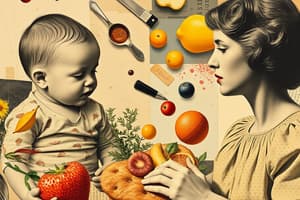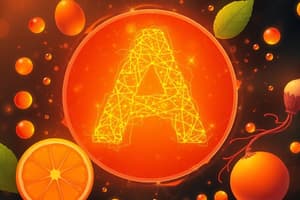Podcast
Questions and Answers
What is a significant role of chloroplasts in plants?
What is a significant role of chloroplasts in plants?
- They are involved in the transport of water.
- They provide structural support to the plant.
- They assist in the process of photosynthesis. (correct)
- They store nutrients and minerals.
Which factor is least likely to affect the rate of photosynthesis?
Which factor is least likely to affect the rate of photosynthesis?
- Carbon dioxide concentration.
- Soil pH level. (correct)
- Light intensity.
- Temperature.
What is the primary function of enzymes in biological processes?
What is the primary function of enzymes in biological processes?
- They catalyze biochemical reactions. (correct)
- They act as a structural component of cells.
- They provide cellular energy.
- They store genetic information.
Which condition is most likely associated with vitamin D deficiency?
Which condition is most likely associated with vitamin D deficiency?
What is the relationship between physical activity and breathing?
What is the relationship between physical activity and breathing?
What is the main function of carbohydrates in the body?
What is the main function of carbohydrates in the body?
What is the main function of lipids in the body?
What is the main function of lipids in the body?
What is the main function of dietary fibers in the body?
What is the main function of dietary fibers in the body?
What is the role of water in the body's chemical reactions?
What is the role of water in the body's chemical reactions?
What is the main function of vitamins and minerals in the body?
What is the main function of vitamins and minerals in the body?
What is the main function of protein in the body?
What is the main function of protein in the body?
What does vitamin C do in the body?
What does vitamin C do in the body?
Where can vitamin C be found?
Where can vitamin C be found?
What is the main function of vitamin D in the body?
What is the main function of vitamin D in the body?
What is the main function of calcium in the body?
What is the main function of calcium in the body?
Where can calcium be found?
Where can calcium be found?
Where can iron be found?
Where can iron be found?
As age increases, the amount of energy needed also increases.
As age increases, the amount of energy needed also increases.
Children need less protein than adults because they are not growing as fast.
Children need less protein than adults because they are not growing as fast.
The more active an individual is, the less energy they need.
The more active an individual is, the less energy they need.
During pregnancy, a woman does not need extra energy or nutrients.
During pregnancy, a woman does not need extra energy or nutrients.
Breastfeeding requires extra energy and calcium.
Breastfeeding requires extra energy and calcium.
What is the name of the condition caused by a lack of vitamin C for more than three months?
What is the name of the condition caused by a lack of vitamin C for more than three months?
What are some common symptoms of scurvy?
What are some common symptoms of scurvy?
What condition is known for poor bone development in children and is caused by a lack of vitamin D?
What condition is known for poor bone development in children and is caused by a lack of vitamin D?
What is the primary function of the digestive system?
What is the primary function of the digestive system?
What are some organs that make up the alimentary canal?
What are some organs that make up the alimentary canal?
Which of the following is NOT a stage of digestion?
Which of the following is NOT a stage of digestion?
What is the main function of teeth in the digestive process?
What is the main function of teeth in the digestive process?
What process involves the breakdown of food by churning in the stomach?
What process involves the breakdown of food by churning in the stomach?
What is the function of bile in the digestive system?
What is the function of bile in the digestive system?
What type of digestion involves breaking down large molecules into smaller, soluble molecules?
What type of digestion involves breaking down large molecules into smaller, soluble molecules?
What is the name of the process where digested food molecules move into the blood and lymph?
What is the name of the process where digested food molecules move into the blood and lymph?
What adaptations in the small intestine help with absorption?
What adaptations in the small intestine help with absorption?
What is the process by which green plants make glucose from carbon dioxide and water?
What is the process by which green plants make glucose from carbon dioxide and water?
What is the byproduct of photosynthesis?
What is the byproduct of photosynthesis?
Photosynthesis requires energy from sunlight.
Photosynthesis requires energy from sunlight.
What are the raw materials needed for photosynthesis?
What are the raw materials needed for photosynthesis?
What are the main factors that affect the rate of photosynthesis?
What are the main factors that affect the rate of photosynthesis?
Different wavelengths of light have no effect on the rate of photosynthesis.
Different wavelengths of light have no effect on the rate of photosynthesis.
What role do chloroplasts play in photosynthesis?
What role do chloroplasts play in photosynthesis?
What is the main importance of photosynthesis?
What is the main importance of photosynthesis?
What is the function of enzymes?
What is the function of enzymes?
Enzymes are specific to one substrate due to their active site shape.
Enzymes are specific to one substrate due to their active site shape.
Enzymes have no optimal temperature or pH.
Enzymes have no optimal temperature or pH.
What is the function of amylase?
What is the function of amylase?
What are some common features of gas exchange surfaces?
What are some common features of gas exchange surfaces?
What are the main structures involved in the breathing system?
What are the main structures involved in the breathing system?
Exhaled air contains a higher percentage of carbon dioxide than inhaled air.
Exhaled air contains a higher percentage of carbon dioxide than inhaled air.
Physical activity has no effect on breathing.
Physical activity has no effect on breathing.
What are the two sets of intercostal muscles?
What are the two sets of intercostal muscles?
Cartilage rings help to keep the trachea and bronchi open during breathing.
Cartilage rings help to keep the trachea and bronchi open during breathing.
What muscles control breathing?
What muscles control breathing?
What is the process by which glucose is broken down to release energy?
What is the process by which glucose is broken down to release energy?
Aerobic respiration releases much more energy than anaerobic respiration.
Aerobic respiration releases much more energy than anaerobic respiration.
What are some processes that require energy from respiration?
What are some processes that require energy from respiration?
Temperature has no effect on respiration.
Temperature has no effect on respiration.
What type of respiration involves the complete breakdown of glucose and releases a large amount of energy?
What type of respiration involves the complete breakdown of glucose and releases a large amount of energy?
What are the products of aerobic respiration?
What are the products of aerobic respiration?
What type of respiration does not require oxygen and releases a small amount of energy?
What type of respiration does not require oxygen and releases a small amount of energy?
Anaerobic respiration in animals occurs mainly during strenuous exercise.
Anaerobic respiration in animals occurs mainly during strenuous exercise.
What is the word equation for anaerobic respiration in animals?
What is the word equation for anaerobic respiration in animals?
What is the word equation for anaerobic respiration in yeast?
What is the word equation for anaerobic respiration in yeast?
Lactic acid buildup in muscles can be beneficial for muscle function.
Lactic acid buildup in muscles can be beneficial for muscle function.
Aerobic respiration produces more energy per glucose molecule than anaerobic respiration.
Aerobic respiration produces more energy per glucose molecule than anaerobic respiration.
Flashcards
Chloroplasts
Chloroplasts
Green organelles in plant cells where photosynthesis takes place.
Rickets
Rickets
A disease caused by vitamin D deficiency, affecting bone development.
Photosynthesis
Photosynthesis
The process by which plants use sunlight to make food.
Factors affecting photosynthesis
Factors affecting photosynthesis
Signup and view all the flashcards
Role of enzymes
Role of enzymes
Signup and view all the flashcards
Vitamin D deficiency
Vitamin D deficiency
Signup and view all the flashcards
Rickets symptoms
Rickets symptoms
Signup and view all the flashcards
Digestive system
Digestive system
Signup and view all the flashcards
Mouth role
Mouth role
Signup and view all the flashcards
Stomach role
Stomach role
Signup and view all the flashcards
Small intestine role
Small intestine role
Signup and view all the flashcards
Large intestine role
Large intestine role
Signup and view all the flashcards
Photosynthesis definition
Photosynthesis definition
Signup and view all the flashcards
Photosynthesis factors
Photosynthesis factors
Signup and view all the flashcards
Investigating photosynthesis rate
Investigating photosynthesis rate
Signup and view all the flashcards
Chloroplast role
Chloroplast role
Signup and view all the flashcards
Photosynthesis importance
Photosynthesis importance
Signup and view all the flashcards
Enzyme definition
Enzyme definition
Signup and view all the flashcards
Enzyme specificity
Enzyme specificity
Signup and view all the flashcards
Factors affecting enzymes
Factors affecting enzymes
Signup and view all the flashcards
Link between physical activity and breathing
Link between physical activity and breathing
Signup and view all the flashcards
Protecting the breathing system
Protecting the breathing system
Signup and view all the flashcards
Respiratory System
Respiratory System
Signup and view all the flashcards
Trachea
Trachea
Signup and view all the flashcards
Bronchi
Bronchi
Signup and view all the flashcards
Alveoli
Alveoli
Signup and view all the flashcards
Study Notes
Necessary Foods
- Carbohydrates: Create energy
- Lipids: Provide insulation and energy storage
- Dietary Fibers: Aid in intestinal emptying
- Water: Essential for bodily chemical reactions
- Vitamins: Crucial for overall health
- Minerals: Important for bodily function
- Protein: Needed for growth and repair of muscles and skin
Vitamins and Minerals
- Vitamin C:
- Creates collagen for healthy skin, bones, hair, and gums
- Found in citrus fruits
- Vitamin D:
- Aids in calcium absorption for strong bones and teeth
- Found in sunlight, fish, eggs, and dairy products
- Calcium:
- Essential for healthy teeth and bones, blood clotting
- Found in milk, cheese, eggs
- Iron:
- Involved in oxygen transport and red blood cell production
- Found in spinach and red meat
Dietary Needs
- Age: Energy needs increase with age, particularly protein for growth in children
- Activity Level: More active individuals require more energy
- Pregnancy: Increased energy and nutrient needs (calcium and iron) for the developing fetus
- Breastfeeding: Extra calcium and increased energy needs for milk production
Scurvy
- Definition: Vitamin C deficiency
- Cause: Lack of Vitamin C for more than 3 months
- Symptoms: Anemia, exhaustion, spontaneous bleeding, pain in limbs, swelling
Digestive System
- Function: Transport food through the body; break down food and absorb nutrients
- Organs: Mouth, esophagus, stomach, small intestine, large intestine, salivary glands, pancreas, liver, gall bladder, appendix, bile duct
- Stages:
- Ingestion: Food enters the mouth
- Mechanical Digestion: Breaking down food physically (chewing, churning)
- Chemical Digestion: Breaking down food chemically (enzymes)
- Absorption: Digested nutrients pass into the bloodstream
- Egestion: Undigested material leaves the body
Teeth and Digestion
- Function: Break down food into smaller pieces to increase surface area for enzyme action
- Teeth Types: Incisors, canines, premolars, molars with differing functions.
- Stomach Function: Churns food, mixes with digestive juices, physical digestion
Chemical Digestion
- Enzymes: Speed up chemical reactions; specific to a molecule
- Amylase: Breaks down starch
- Proteases: Breaks down proteins
- Lipases: Breaks down lipids into fatty acids and glycerol
- Hydrochloric Acid: Creates an acidic environment for enzymes to work (in stomach)
Digestion of Starch, Proteins, and Fats
- Starch: Amylase breaks it down into smaller sugars (maltose)
- Proteins: Pepsin (stomach) and trypsin (small intestine) break proteins down into amino acids
- Fats: Bile emulsifies fats, increasing surface area for lipase action
Absorption
- Nutrients are absorbed in the small intestine.
- Villi increase surface area for absorption to occur efficiently.
- Thin walls of villi allow efficient diffusion and active transport
Photosynthesis
- Process: Green plants use carbon dioxide and water to produce glucose and oxygen, using energy from light.
- Chlorophyll: Essential pigment for trapping light energy
- Factors Affecting Photosynthesis: Light intensity, carbon dioxide concentration, temperature, and light wavelength.
Respiration
- Function: Release energy from food (glucose) for bodily functions
- Aerobic Respiration: Requires oxygen; produces carbon dioxide and water; more efficient.
- Anaerobic Respiration: Does not require oxygen; produces lactic acid (animals) or ethanol and carbon dioxide (yeast); less efficient.
- Importance: Cellular energy for functions
Studying That Suits You
Use AI to generate personalized quizzes and flashcards to suit your learning preferences.




